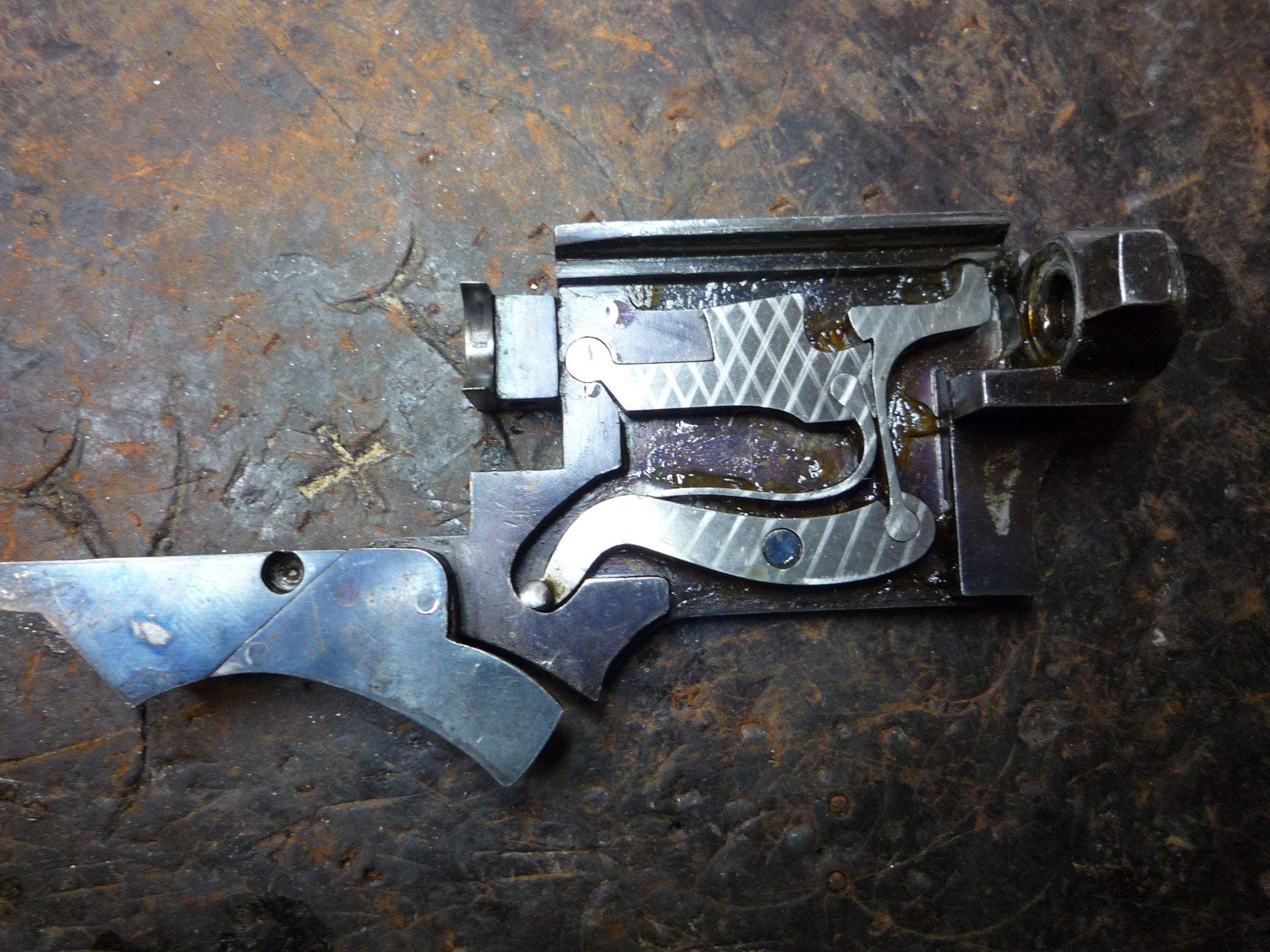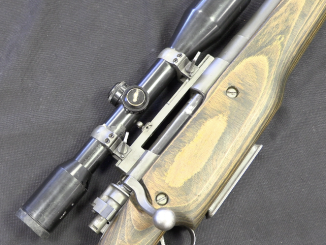Today we are checking out a bespoke gunsmith’s project; a DeLisle-inspired .45ACP Mauser built by Lars Rannstad Slang of Oslo. Using a commercial small-ring Mauser action, he fabricated a new bolt head, trigger guard, follower, and large aluminum mono-core suppressor to built a rifle that functions like a classic SOE DeLisle silenced carbine but with the aesthetics of a classy 1920s sporting rifle. It feeds from 5-round stripper clips, with an internal magazine instead of the original detachable magazine configuration of the DeLisle.
Thanks to Lars for giving me a chance to do some shooting with this awesome unique piece! You can follow all his projects on Instagram: https://www.instagram.com/gunsmith_lrs/




That’s a lovely little bit of work. I’d love one, for pest control…
Well, if DeLisle had two years, more of a budget, and a fine custom shop maybe he’d have produced something more reliable, though the amalgam of SMLE, 1911 mag, and tommygun barrel has just the right steampunk ring to it.
Dig the brass-jacketed bullets — made by who? And how accurate was this rig?
The issue of accuracy is one criticism I have of Ian’s presentations. He is out at the range shooting the firearms. So why not do a bit of structured accuracy-at-range testing. I am thinking about shooting from a rest to gauge the inherent capabilities of the firearm. Ian concentrates so much on the history of the development of firearms, that you would think that the increase/decrease in accuracy, with each new innovation, would be a critical test of whether newer really is better.
With the age and condition of most of the arms he evaluates, accuracy tests would rarely be indicative of a typical one in excellent condition.
Not sure there is any practical use for the rifle, except spooky “wet work”. But very nice take on the original.
Pest control. Or the inability to adapt.
Load it with 200-grain JHPs at 900 F/S and you’ve got just about the perfect in-town animal control arm.
Stray dogs, raccoons, skunks and etc., any or all of which can carry rabies, are too tough a target for the .22 LR, and the .22 WMR is loud.
A suppressed .45 ACP would just about fill the bill for this sort of work.
clear ether
eon
Yeah, you might be surprised at just how effective .22 LR isn’t, on certain pest species.
I had a bit of a problem with a feral cat that was attacking all and sundry, when my friend’s kids were wee tots. Being the resident thug, I was importuned to “do something”, and I’m here to tell you that starting out with a .22 CB and then going to a .22 LR…? Mistake. Tried, as a last resort, using the .22 WMR center-of-mass, only to experience failure yet again. All rounds were in the thoracic cavity, and I eventually had to resort to full-house 9mm Parabellum on that damn cat. The 9mm was a mercy kill, and I was horrified that I’d put that poor animal through that. .22? Never again…
For those wondering, I had to preserve the head for rabies testing after the cat bit one of the kids. Not a pretty situation, for all concerned.
Out in the country, my usual raccoon inoculator was a 1911 .45 with 230-grain FMJ. .38 Special high-speed LRN worked for head shots, but was a through-and-through wounder otherwise.
Norma 10mm Auto 180-grain JHP (Glock 20) was the way to go on skunks. Pepe le Pew is tougher than you might think, not to mention smarter and meaner.
The last time I eliminated a raccoon here in town, it was with a three-foot length of former snow-shovel handle.
Like the Preacher said in Pale Rider, sometimes there’s nothing quite as useful as a nice piece of hickory.
cheers
eon
Yeah, and there’s nothing better blood-red hickory for making everyone around you look at you like you’re a serial-killing maniac…
@Kirk;
Actually, it never broke the skin. Just the little bugger’s neck and skull.
Ok, my having been trained in baton and hanbo techniques OUAT probably helped.
😉
cheers
eon
Why not a shotgun? Loud but a lot safer in an urban area.
Not really. Buckshot, even as small as No. 4, is prone to overpenetration on most structural materials such as wood or drywall. It will penetrate aluminum siding.
Slug loads will go through an animal much below large dog size. And pose a danger on the far side of same.
About the only safe option is No. 6 birdshot. And you need to be very close (within five to ten feet) to ensure that the shot column hasn’t begun to disperse before it hits. (Power piston loads are definitely recommended for this reason.)
Probably the least-worst option would be a pistol caliber with some “prefragmented” projectile like the MagSafe (no longer made) or Glaser Safety Slug (available from Cor-Bon);
https://en.wikipedia.org/wiki/Glaser_Safety_Slug
Essentially a small, high-velocity “shot load”.
clear ether
eon
Did a bit of research on the Glaser Safety Slug. Seems its usefulness is in real up close encounters, in environments where overpenetration is a large risk. Examples are a store clerk being robbed or an apartment break in where the only barrier between the occupant and their neighbor’s unit is sheetrock. So rather expensive with limited use, but if you are in the correct situation, could be very effective. Might be more wound and scare away an attacker than anything more deadly. But lots of time that is enough.
@Bart;
I used a 9mm Glaser on a boar coon once (Walther P.38). About two and half feet nose to tail and weighed 22 pounds. He was DAS. He was up on his hind legs and snarling at me when I fired.
Doing a bit of PM, I found that it had entered just to the right of his breastbone, about 2″ aft of his front legs. It pretty much puree’d a volume about 5″ in diameter, taking in heart and both lungs.
I’m pretty sure a .44 Magnum or .45 ACP Glaser, being larger, would have nearly blown him in half.
Glasers seem like a screwy concept, but they do work.
cheers
eon
If I were an ornery old boar raccoon with a tough hide and a surly disposition, I would be honored to be bumped off with a beautiful firearm like this, and certainly insulted by anything less. That said, what’d he do to the bolt face? Isn’t .45ACP pretty close to a normal Mauser head diameter?
“Pretty close to” might not be good enough for proper seating of the rim, headspacing, etc. The PPS-43 bolt for the original 7.62×25 Tokarev ammo is “pretty close to” what is needed for 9mm. But I have read that when converting the PPS-43 to 9mm, a bit of work can be needed on the bolt face to make 9mm work properly. It would be interesting of the gunsmith published the details of what he did.
“Pretty close to” might not be good enough for proper seating of the rim, head spacing, etc. The PPS-43 bolt for the original 7.62×25 Tokarev ammo is “pretty close to” what is needed for 9mm. But I have read that when converting the PPS-43 to 9mm, a bit of work can be needed on the bolt face to make 9mm work properly. It would be interesting of the gunsmith published the details of what he did.
He had to completely replace and reconfigure the front of the bolt because it is shortened so much. This is an extremely short-actioned mauser…he had to cut it apart between the front and rear receiver rings and re-weld it. So, the front of the bolt had to be remade correspondingly much shorter, with integral rib replacing the former claw extractor to effect bolt smoothness of operation. It’s really impressive. Yes, the head of the 45 ACP is the same as the .473 inch case head diameter of all the “standard” mauser cartridge derivatives.
Two tax stamps and a Fed.permission slip for that very nice little carbine? Fails on the scales. Beautiful work none the less. Super looking package.